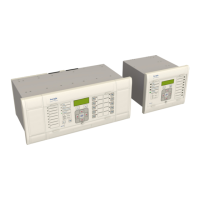where:
●
DQ
H,R
= winding hottest spot rise ov
er top oil temperature at rated load. This parameter is set by the user
● K
U
= the ratio of actual load to rated load
● m = winding exponent (Winding exp m setting)
2.2.3 THERMAL STATE MEASUREMENT
DHot spot temperatur
e, Top oil temperature and ambient temperature are stored in non-volatile memory. These
measurements are updated every power cycle. The thermal state can be reset to zero by any of the following:
● The Reset Thermal cell under the MEASUREMENT 3 COLUMN on the front panel
● A remote communications interface command
● A status input state change.
The top oil temperature, hot spot temperature, ambient temperature and pre-trip time left are available as a
measured value in the MEASUREMENT 3 column.
If you need a more accurate representation of the transformer thermal state, you can use temperature monitoring
devices (RTDs or CLIO), which target specific areas. For short period overloads, RTD, CLIO and overcurrent
protection techniques provide better protection.
The PSL provides a signal indicating that the transformer is de-energised (TFR De-energised). This signal is
asserted when all the circuit breakers are open. In this case, the transformer no-load losses are not considered. As
a result, the top oil and hottest spot temperatures are equal to the ambient temperature when the monitored
current is zero. If this signal is removed, the top oil and hottest spot temperatures are not equal to the ambient
temperature even when the monitored current is zero. In this case the top oil and hottest spot temperatures will
increase according to the described equations.
2.3 APPLICATION NOTES
2.3.1 ALSTOM RECOMMENDATIONS
Monitored Winding
Y
ou can set the monitored winding to HV, LV, TV or Biased Current. We recommend setting it to Biased
Current to provide an overall thermal condition for the transformer.
Ambient Temperature
Ambient temperature is an important factor when determining the load capability of a transformer, because you
add it to the temperature rise due to loading to determine the operating temperature. IEEE C57.91-1995 states
that transformer ratings are based on an average ambient temperature of 30°C.
The Ambient T Source setting defines whether the ambient temperature should be set to an average level or
measured directly using a CLI or RTD input. When measuring the ambient temperature, it should be averaged over
a 24-hour period.
Top Oil Temperature
The Top Oil T source setting defines whether the Top Oil temperature is calculated or measured.
We recommend setting the rated load (Rated Current) to 1.0 pu.
2.3.2 IEEE RECOMMENDATIONS
Winding Exponent
IEEE C57.91-1995 suggests the following winding and oil exponents.
P64x Chapter 7 - Transformer Condition Monitoring
P64x-TM-EN-1.3 147

